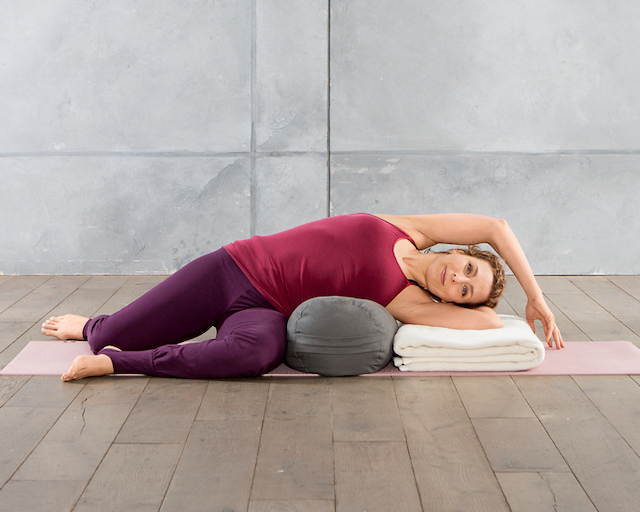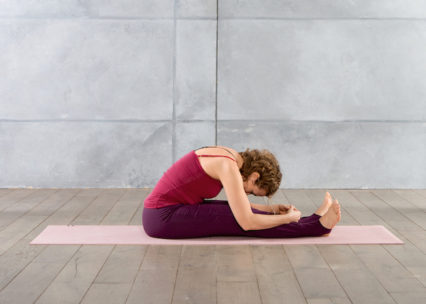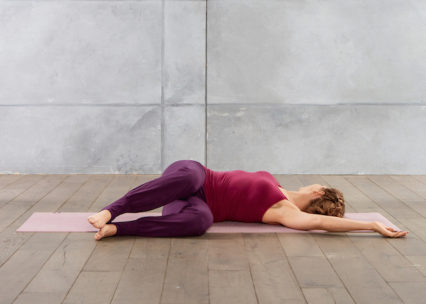4 Yoga Poses to Save You From Burnout
Getty/ CreativaImages
Create space for self-healing with a yoga sequence designed to cultivate your receptive nature.
In our busy world, burnout has become a common and even fashionable complaint. We power through late nights at work; messages bombard us even after leaving the office; and performance pressure haunts us in the classroom and workplace alike. Living in this hyperactive environment, it is no wonder so many of us experience burnout—total physical, emotional, or mental exhaustion.
As a yoga teacher, I long thought myself immune to this modern epidemic. For years, I relished my busy lifestyle. I ran my own yoga studio, authored several books, produced DVDs, and trained other yoga teachers all while raising two daughters with my husband. But even I—who meditates and relaxes for a living—fell victim to burnout.
Over time, I became more and more tired and my body began to ache. I even lost the energy for my own yoga practice, and could hardly stay awake for meditations. I could not believe I was facing burnout—I was a yoga teacher! Yoga teachers are always in balance, right?
Not so. Based on the teachings of the Tao, each person is characterized by Yin and Yang, two opposing—but harmonious—forces. The busy lifestyle we lead exhausts our Yin, while saturating us with Yang. The aim of Yin Yoga, based in ancient tradition, is to bring the body, mind, and spirit into harmony, and its teachings are more relevant today than ever.
Yin Yoga puts us in touch with our body, our mind, and our inner self. By giving us the peace and calm we lack in this noisy world, Yin Yoga’s long, deep stretches teach us to hear and interpret signs from our bodies and become aware of what is going on inside of us both physically and emotionally. Identifying the causes of our stress allows us to accept, process, and ultimately let go. In this way, Yin Yoga activates the liberating process of self-healing.
It is an intensive yet passive practice; the exercises are carried out without any muscular tension, and breathing should be effortless. In Yin Yoga, you hold each position for around three to five minutes and your body remains as relaxed as possible.
Yin Yoga teaches us a wonderful way to let go physically, emotionally, and mentally. Today, I can only reflect on what a gift it was to discover Yin Yoga in my life at a time when I was drained and overwhelmed. I hope you will feel how even a short break, in which focus is placed consciously on breathing and sensation, can bring new energy into your life.
This short sequence of easy poses can help to recharge your batteries, so that you can experience the beautiful energies Yin has to offer.

Lying Banana (Bananasana)
Place a yoga bolster or a rolled-up blanket straight across your mat and sit to the right of the bolster. Now tilt your upper body left and place yourself in a relaxed way on the bolster. Your head rests on your left arm, which you can also support with a blanket. Bend your legs comfortably, or (for more opening of the hips) take them to a 90-degree angle. Stretch out your right arm leftwards over your head. Let your weight go downwards.
Hold the position for three to five minutes, then push yourself back up and change sides.

Lying Butterfly (Supta Baddha Konasana)
Lie back on the mat and place a yoga block under your head, and a second one at shoulder height under your thoracic spine. Alternatively, you can use a soft cushion under your head. Bring the soles of your feet together, and let your knees sink outwards slowly. Should the stretch be too intense on the insides of the legs or the groin, you can place more blocks or cushions under your knees. Stretch the arms out long next to your head, and place them on the floor so that you can feel a stretch in the chest and shoulder area. If your fingertips go numb doing this or you do not have the range of motion to do this, change the position of the arms so that the hands are more at your side or on your stomach.
Stay in the position for three to five minutes. Take the arms back next to your body, close your legs, and push yourself up with an activated pelvic floor. Place the props to one side and relax to the floor.

Caterpillar (Pashchimottanasana)
Sit on the floor or on a cushion and stretch the legs out long in front of you. Keep the feet very loose. Relax your back and tilt your upper body forward. Do not tighten up while doing this; sink down gently with a rounded back. Place your hands where they naturally land.
For a softer version, you can also place a yoga bolster under the hollows of the knees or bend the legs more. If the stretch is too strong in the neck, then move about to and fro in between, or support your head with blocks or pillows.
In addition to the stretch, here you can also activate the bubbling spring acupressure point, the kidney point on the sole of your foot that is located directly underneath the ball of the foot in the middle. It counteracts anxieties and exhaustion, clears and calms the mind, and grounds you. Bend your legs a little if you cannot otherwise reach this point with your fingers.
Remain in Caterpillar for three to five minutes. If you like, press the acupressure points very gently, as long as it feels comfortable.

Twisted Roots (Jathara Parivartanasana)
Lie on your back, pull your knees up to your chest, and let your bent legs sink onto the floor to the left. You can place your arms to the side at shoulder height, or stretch them out on the floor above you. Look towards your right hand if you want to include a rotation in the cervical spine. Give all your weight to the floor and breathe into your stomach to intensify the massaging effect on your stomach organs.
If you want to intensify the stretch, you can try the following version: Start by lying on your back, place your feet hip-width apart on the mat, and let your knees fall to the side as described above. Now release the lower foot from the floor and place it on the outside of the upper leg or on the knee.
Stay in the selected position for three to five minutes. Then come back to the center, grip your knees and press them briefly to your chest, rock to and fro a few times, and then change sides. Afterwards relax into the floor for as long as you like.
Adapted and excerpted from Be Healthy with Yin Yoga: The Gentle Way to Free Your Body of Everyday Ailments and Emotional Stress by Stefanie Arend (She Writes Press, August 2019).
Photo credit: Forster & Martin Fotografie, Munich
Need more methods to cope with burnout? Discover more ways to take a break from overwhelming situations.

